After you have completed the wonderful journey on the South Coast Track from the Rarakau Car Park to the magical Westies Hut it is possible to continue the journey all the way to Puysegur Point Lighthouse, the Te Oneroa shelter and the ruins of the old mining town of Cromarty way out at Preservation Inlet – as well as the ‘fabulous’ Kisbee Wilderness Resort which you will no doubt not be able to afford to stay at! At least I wouldn’t.
Conversely you might do better to get dropped out there by float plane or chopper and make your way back. The advantage of a helicopter would be that you could leave supplies at Westies or the fabulous Waitutu Lodge on the Wairaurahiri River (for example) so you didn’t have to carry them all the way back. Then you could spend a few days resting and enjoying yourself at that incredible spot. There are plentiful fish and lobsters in the lagoon and deer walking by the cave entrance on the beach. I wish we had. I would /will walk back there sometime so we can do just that! This is true wilderness trekking through forests where no man ever lived and trunks which never felt an axe. The more I learn about this section, the more I want to ‘give it a go’. At the moment (August 2018) at 69 and with a dodgy knee and slipped disc in my back (and having difficulty working on a fence in the back paddock!) I don’t know…but I have recovered before, so who knows?
This is the view Della and I took in 2016 looking westwards from Westies. The wonders just go on and on:
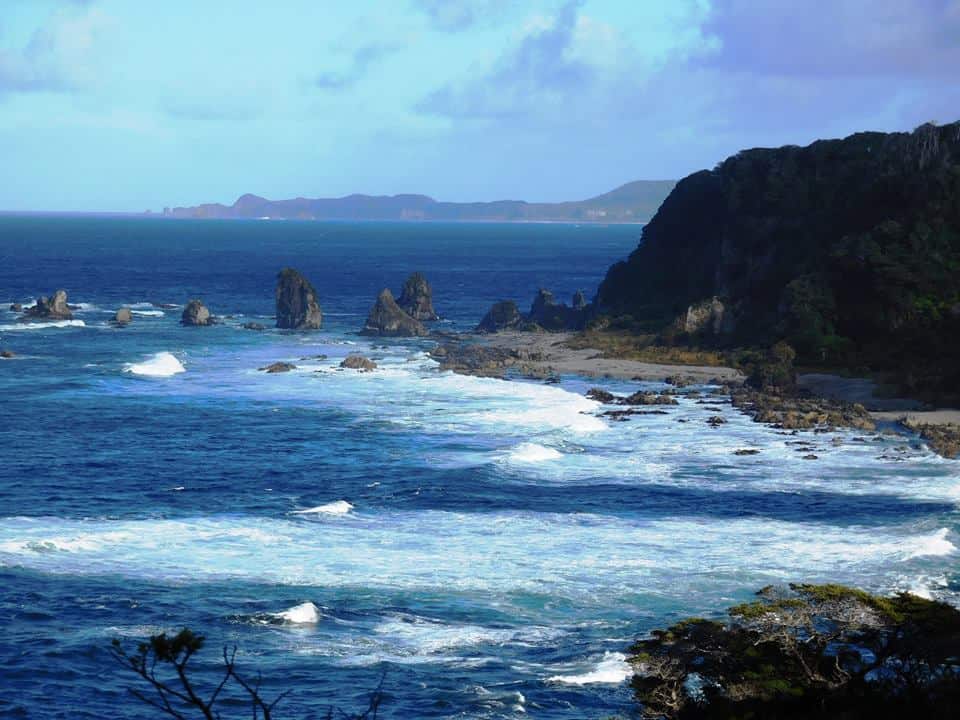
I have found only three accounts of this incredible adventure.
This account in NZ Geographic: https://www.nzgeo.com/stories/walking-the-line/ by Kennedy Warne is almost encyclopedic. There is lots of interesting history of what used to be the ‘telegraph track’ built to create and maintain a line out to the lighthouse at Puysegur Point. You come across sections of this wire here and there and see old insulators nailed to tree trunks on the way out from the Wairaurahiri. The detail in Kennedy’s account should provide an excellent guide for anyone young and adventurous enough to try this track. There is further detail in Moir’s (below). I will not spoil your reading of it by saying more – only do read it. It was clearly a wonderful trip.
The second one is by Tristan Riley (https://web.archive.org/web/20170406113730/http://www.tristanriley.co.nz/blog/archives/149) Tristan’s website seems to be broken so I have copied the contents from the internet archive’s version of it. I hope he doesn’t mind. What it is to be young and fit. I would dearly like to do this trip, but at just shy of 70 (and having taken 4 long days to get to Westies in 2016 – which took Tristan two!) I doubt my ability. Still I am (maybe) getting fitter every day, so maybe I will yet.
Tramping the Telegraph – a trip to Puysegur Point:
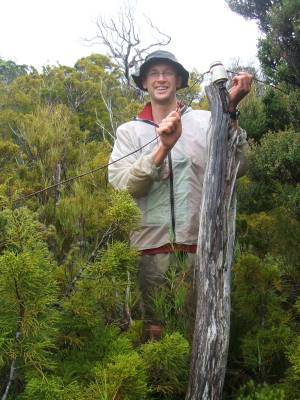
Puysegur Point at last! Thunder rolls, lightning strikes the ocean and waterfalls fly upward in the wind. Titi wheel out to sea as Tasman rollers pound the point. A dramatic arrival at one of New Zealand’s most remote spots. Matt and I carried on to the welcome shelter of the old landing shed at Otago Retreat, to enjoy the taste of fresh rainwater after days of Fiordland tea.
We had arrived at Puysegur following the 1908 telegraph line route along the coast from Big River. Expecting days of diabolical, tight coastal scrub I was surprised by the ease of travel. The telegraph line adds interest, popping up in unexpected places with lengths of steel wire, trees cut off as poles, and porcelain insulators. Old gold mines, wild beaches, sea caves and fantastic coastal forest made for a great trip. Map and compass were in constant use, to navigate the wild expanse of plateau on our return via the inland route from Kisbee Bay to Hill E.
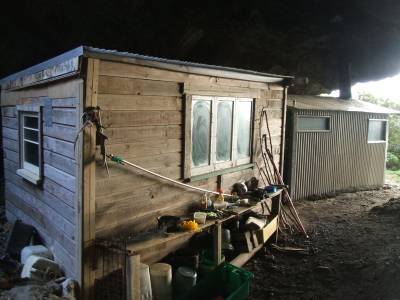
Day 3 – Westy’s Cave to Andrew’s Cave
After two-day’s walk along the South Coast track we arrived at Westy’s Cave, a character hut tucked into a sea cave. With wild seas and few visitors, Westy’s is a great place to hide out. An hour on, Big River is a spectacular spot, the junction of lake and coast. Rounded boulder and orange pingao frame a view to Green Islets, our day’s journey away.
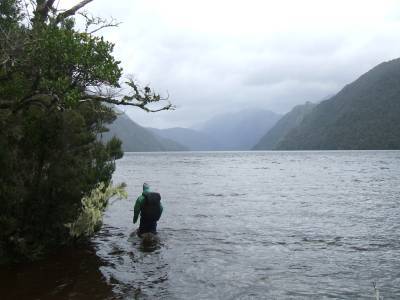
Big River provides the main obstacle to Puysegur. The 50m wide, deep crossing is affected by the tide and could easily flood and block an exit. On our return trip we found the lake had dropped by 50cm. Wading along the shore among beds of freshwater mussels is fun. The biggest climb of the trip is the 300m scramble up and over to Cavendish River. The swampy flats, tangled bush lawyer and swampy guts remind us that yes, we are still in Fiordland!
The most difficult section of the trip was the descent of Andrew Burn to the sea. Foolishly ignoring deer trails, we sidle the steep sides of the gorge until eventually emerging on the coast.
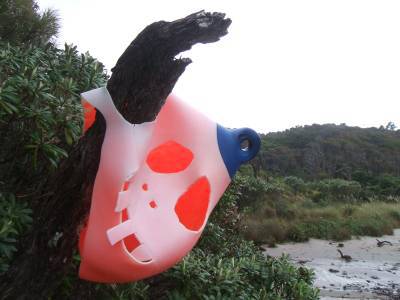
Day 4 – Around the Coast to Gates Harbour
After a night in a sea-cave, we wandered around the coast to Green Islets. A fur seal colony provides comedy in the posturing of the beach master bull. Crossing the peninsula to the west, the force of the wind hits and a truly wild coast appears. Orange pingao dunes are covered in rare Euphorbia glauca. Cooks Turban, catseye and massive paua shells lie among the kelp, polished to mother-of-pearl.
A compass bearing carries us west, through orange Halocarpus scrub to a crossing of Kiwi Burn at the mouth. More beach, gravel and boulder to Long Reef, then easy travel (and a brief swim in the sea for Matt) to a pleasant camp at the head of Gates Harbour.
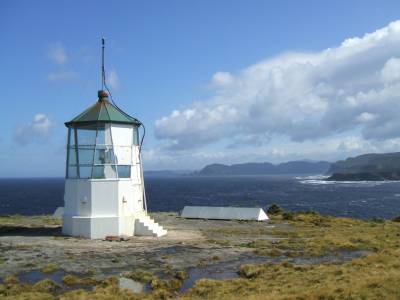
Day 5 – Wilson River, Macnamara Creek, Sealers Creek to Puysegur Point
Open coastal forest became flatter and easier, cut in by steep sided creeks. Kaka and kakariki cackle and big rata impress, though the undergrowth is sadly depleted by deer. Despite the carnage we bless the deer as we walk, following trails around obstacles. Rain floods the bush creeks, but the bigger crossings are fine at the river mouth. A karearea calls our arrival at Sealers Creek, the river cutting between three impressive islets. From here a track leads to Puysegur.
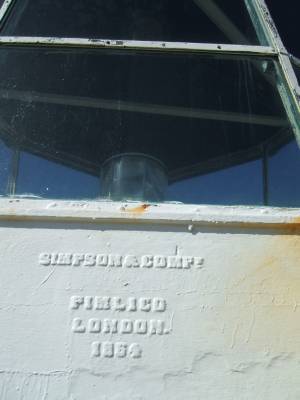
Day 6 – Te Oneroa shelter
Our rest day, a return to the lighthouse in fine sunny weather revealed an impressive vista of Coal Island and Preservation Inlet. 3 hours walk took us to the Te Oneroa A-frame, swarms of sandflies and a big feed of mussels.
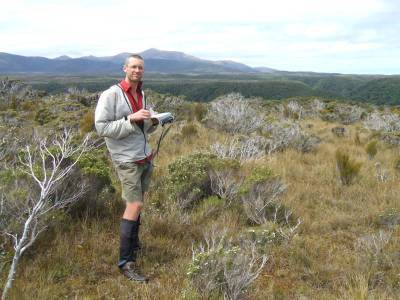
Day 7 – Plateau between The Knob and Lake Kiwi
Popping in to visit the caretaker at Kisbee Lodge, the only people for miles around, we found a pretty flash setup. Carrying on up the wooden-railed bush tramway, munching our bag of crayfish legs, we soon passed The Knob.
A wide manuka covered plateau, dissected with squiggling creeks, offers fantastic views of the ocean, Solander Island and Bald Peaks. It was a strange feeling to be on the flat, in Fiordland! Travel and navigation are easy, with some tree climbing to obtain bearings. In bad weather this stretch would be miserable.

Day 8 – Hill E and return to Cavendish River
Ignoring the route described in Moirs Guide, we bypassed Lake Kiwi and soon returned to Hill E and the swamps of the Cavendish.
Day 9-11 Hitch-hike a Jetboat ride up Wairaurahiri River to Lake Hauroko
Matt had met a team of adventurers from South Coast Jet at Waitutu Hut. Hearing about our trip they kindly offered a ride out on their jetboats. The trip along the coast in 2m swell was white knuckle stuff, fantastic! Blasting up the Wairaurahiri into the mighty Lake Hauroko was excellent. Thanks to Vaughn, Steve, Stuart, Nick and the boys for the trip and kaimoana!
The third account from 1966 is here: https://issuu.com/cleangreen/docs/southcoasttrip This trip was undertaken before ever there was a South Coast Track. The team went on past Puysegur Point to Lake Monk (from where they flew out by float plane). It is very detailed and should be read carefully by anyone contemplating such a trip. It should be noted that they carried rifles and fishing tackle so they could supply themselves with plentiful fish, pig and deer. One of the great Southern adventures!
For more detailed information about some sections of the track see also:
http://www.theultralighthiker.com/westies-hut/
http://www.theultralighthiker.com/south-coast-track-fiordland-nz-wairaurahiri-to-waitutu-2016/
http://www.theultralighthiker.com/dusky-south-coast-tracks/
http://www.theultralighthiker.com/fiordland-2014-2/
http://www.theultralighthiker.com/a-walk-in-fiordland/
http://www.theultralighthiker.com/bucket-list-westies-hut/
http://www.theultralighthiker.com/fiordland-wairaurahiri-to-rarakau/
http://www.theultralighthiker.com/fiordland-wairaurahiri-to-waitutu-part-4/
http://www.theultralighthiker.com/westies-hut-topo-map-errors/
http://www.theultralighthiker.com/waitutu-forest-fiordland-warm-air-pockets/
Some notes from Moir’s Guide:
TE WAEWAE BAY TO PRESERVATION INLET
The track to the Edwin Burn is well marked and graded, being part of the Hump Ridge Track. From here on to Big River, the track is on the whole good, if rather boggy between Wairaurahiri and Waitutu Rivers. All the viaducts are in good order. The route from Big River on to Preservation Inlet, however, is entirely different, with no formed track and should be attempted only by stoical, experienced parties.
Parties are encouraged to make a donation to the Southland Port Craig Viaduct Trust, PO Box 857, Invercargill towards the upkeep and maintenance of the Port Craig viaducts. For a description of the Hump Track, Hump Ridge Track and the routes to the southern end of Lake Hauroko and the Wairaurahiri River, see those sections.
BLUECLIFFS TO PORT CRAIG
From Tuatapere, turn off onto the Papatotara Road and follow the signs to Bluecliffs Beach. Cars may be left at the carpark, or in front of the Rarakau Station homestead on the hill above the track entrance, but first notify the farmer.
From the Rarakau carpark, follow the well graded Hump Ridge Track through bush along the top of the sea cliffs to the footbridge across the Waikoau River, an hour from the carpark, where there are some cribs. Alternatively, at low tide walk along the beach. Deduct 2 hours 2.0 minutes from the Bluff tide tables for Port Craig tides. From the Waikaou River, either the beach or the track may be followed for another 6 1/2 kilometres to the western end of the Bluecliffs Beach. From the end of the beach, follow the remains of a logging road for a kilometre and cross the footbridge over the Track Burn to the start of the South Coast Track.
The track from the Track Burn is well graded for about 45 minutes to the Flat Creek bridge. Fron here, travel is on the beach apart from two short sections that cross headlands. Half an hour from Flat Creek, at Breakneck Creek, the track resumes to head inland up the true-right bank. This track is used if the tides are above half tide as otherwise the stunning beach may be followed instead. Depending on the time of day, yellow eyed penguins and dolphins may be seen. The only way back onto the track after Breakneck Creek is at The Whata where a well signposted track climbs some distance up to the bush terrace and main track at the western end of the bay. The old Port Craig Schoolhouse, which is now a 20 bunk hut, lies half an hour farther. The schoolhouse is a building of high historical significance and parties should treat it as such. Even if parties do not intend to continue from here, it is worthwhile making the short trip to the first of the viaducts described below.
Times: Car park to Port Craig via beach, 5-6 hrs; Carpark to Port Craig, via track, 6-7 hrs.
PORT CRAIG TO WAIRAURAHIRI, WAITUTU AND BIG RIVERS
From the Port Craig Schoolhouse, the track heads south along the old logging tramline that makes a well graded track for the next 15 kilometres, almost to the Wairaurahiri River where there is a 12 bunk hut. About 1 1 /2 hours from Port Craig is Sandhill Point, which is tapu to the local Maori—please do not leave the track here. Beyond Sandhill Point are four viaducts on the old tramline, all of which have been re-decked. At the end of the tramline, the track enters un-logged forest and drops down three terraces to the clearing beside the hut. As an alternative route, the coast can be followed from Sandhill Point, but the trip should be timed for the tide to be halfway out between the Francis Burn and the Wairaurahiri River. A swing bridge crosses the Wairaurahiri River at the hut and the track continues through tall podocarp forest for 13 kilometres to the Waitutu River. The track is inland from the coast and is well formed. There is a walk wire over Crombie Stream and swing bridges over the Angus Burn and Waitutu River. After crossing the Waitutu River, follow upstream about 100 metres to find the 12 bunk Waitutu Hut.
The track to Big Rivet commences at the western end of the hut and again follows the remains of the Puysegur Point-Orepuki telephone line. All that can be seen now is some occasional wire, insulatots and trees sawn off about three metres up that were used as telephone poles. There are swing bridges over ihe Grant Burn and the Aan River, but no more huts past the Waitutu River. On reaching Big River, follow the river up until opposite a little island. Ford the stream to this island and, provided the main channel is not in flood, continue straight over to the other side of the river. A camp can be made here, at the old hut site, B46 417271.
Many consider it faster and easier to walk around the beaches for most of the way from Waitutu River to Prices Harbour, providing there are no heavy seas. Unless headlands are skirted, some wading is required at B46 495249 and the beach around the headland before Prices Harbour is best avoided. Westies Hut, a four bunk hut built in a cave a little above the high tide mark, can be found at the west end of Prices Harbour, opposite the island a little offshore.
Times: Port Craig to Sandhill Point, 1 1/2hrs; Sandhill Point to Wairaurahiri River, 4-6 hrs; Wairaurahiri River to Waitutu River, 5 hrs; Waitutu River to Big River, 5-13 hrs.
WAITUTU RIVER TO THE SLAUGHTER BURN AND POTERITERI HUTS
On the true-left of the Waitutu River, on the terrace just before the South Coast Track descends to the river, a lightly marked route up the Waitutu River may be picked up. For the most part, the route follows through open forest and fern understorey along the edge of the terraces above the river. The route drops abruptly to the river at C46 534270 and continues up the true-left to a swing bridge just below the Slaughter Burn confluence, at C46 529 293. The four bunk Slaughter Burn Hut lies on the true-right of the Slaughter Burn (neither named on C46, nor gazetted), 150 metres up stream.
The lower sections of the Slaughter Burn consist of open flats and provide easy travel to a lightly marked route leading up to the relatively open south-east ridge of Mt Aitken. From Mt Aitken there is good travel along an easy ridge to north of Solitary Peak. The valley at the head of Lake Mouat may be reached by experienced parties by descending northwards from Pt911 metres to some steep bluffs through the bush to midway along a shoulder above the top of Lake Mouat and then a final steep descent to a tarn a little north of the lake itself.
Alternatively, carry on up the true-left of the Waitutu River from the swing bridge, following a route along the ridges to Poteriteri Hut.
Times: Waitutu Hut to Slaughter Burn Hut, 3 1/2hrs; Waitutu Hut to above Lake Mouat, allow 2 days; Waitutu Hut to Poteriteri Hut, allow 1 day.
BIG RIVER TO HILL E
From Big River there is no formed track and travel is through dense, stunted bush that is difficult to push through. Over-trousers are recommended to protect the legs from scratches. In the past it has been the usual practice to try to follow the old telephone line to Puysegur Point. However, as considerable extra time can be wasted in trying to locate the line of the old track, which tends anyway to be replaced by dense regeneration, it is probably better to work out one’s own route. From the area around Hill E onwards there is no obvious best route.
Head up stream from the Big River Hut site, B46 417271, and skirt the shoreline of Lake Hakapoua until about two kilometres from the hut site, B46 415291. Some parties report that it better to wade the shores of the lake to avoid the swampy shoreline. From here, head west to cross the saddle into the Cavendish Valley and follow the East Branch of the Cavendish River down to its junction with the main river, which is a suitable crossing place. Unless there has been high flooding, there is normally no problem in crossing the Cavendish, nor the next river, the Fred Burn although it does flood easily. By following the Cavendish River up from the junction for about ¾ kilometre, a direct east-west approach can be made to the Fred Burn saddle. From the saddle, continue in the same general direction to cross the Fred Burn at the junction of its north and west branches and follow along the south bank of the latter, occasionally meeting with the phone line. Now climb gradually out of the valley and sidle round the northern slopes of Kakapo Hill, where the remains of an old P&T maintenance hut may be seen. From here, continue west to ascend a ridge leading up to Pt 446 metres, the summit of Hill E, for the inland route that continues north-north-west along the line of the old gold miners’ trail to Cromart v. Parties choosing the easier coastal route can head either for Hill E or for the saddle between Hill E and Kakapo Hill.
Time: Lake Hakapoua to Hill E, allow 1-1/2 days.
HILL E TO KISBEE BAY, PRESERVATION INLET VIA THE INLAND ROUTE
Old maps show that the 1890s goldminers’ route headed more or less straight from Hill E to the outlet of Lake Kiwi. Following a bearing a few degrees north of this to about halfway along the eastern shore of Lake Kiwi has been traversed more recently and would seem to cross easier contours. From here, there are good deer trails leading round the shoreline to the Kiwi Burn, which is reached in about four hours from Hill E.
The outlet of Lake Kiwi lies in a small flat area and the Kiwi Burn is crossed easily under normal weather conditions. From the small beach on the far side, climb straight up the steep slip to the west to reach a flat area on top. This is a suitable place to camp and probably safer than the beach, which could flood. From here, head in the direction of The Knob which can be seen clearly from the tussock flats when they are reached. Although there is a certain amount of open country here, there are also some patches of dense scrub that have to be traversed. Some parties have followed a more northerly route until more or less east of Kisbee Bay before heading south-west to pick up the Cromarty track. The more direct route is described here.
Aim to cross the Wilson River at the junction of its north and east branches. Do not descend into the Wilson gorge south of the junction as this is very steep. There is a good ridge leading down to the junction and after crossing the river, a deer trail leads straight up through the bush to the open country of The Knob. Continue round the north side of The Knob to strike the Cromarty-Golden Site tramline that provides excellent travel and thence carry on down to Kisbee Bay. There is a shelter at Te Oneroa, 3 hours further down the inlet, or 2 1/2 hours if the tide is low.
Times: Hill E to Kisbee Bay, 2-3 days. Lake Kiwi to the Knob has been walked in a long day, but probably more time should be allowed, particularly if the Wilson River is in flood. The tramline takes about 2 hours down to Kisbee Bay.
HILL E TO PUYSEGUR POINT VIA THE COASTAL ROUTE
Descend from the saddle between Hill E and Kakapo Hill, sidle across to the Andrew Burn and drop down steeply into it. Follow the stream to the sea where, on the east side of the stream mouth, there is a huge cave, complete with fire, seats and table.
Carry on along the beach to Green Islets, which has beautiful rock formations. Seals and penguins may be seen in the caves near the seaward point. Climb up a steep bank at B46 308244 and cross the peninsular by way of a gully and drop down to the beach at the Grace Burn. At B46 295253, climb up a slip and into the bush again to pick up the telephone line almost immediately. It is now difficult to follow the telephone line so the best alternative is to follow a compass bearing to the Kiwi Burn mouth. Here, the Kiwi Burn can only be crossed at low tide. At other times, the first ford is about 600 metres up from the mouth.
From the mouth, travel along the beach to Long Reef, taking care to avoid any quicksand at the Gold Burn. A side trip to Long Reef point is worthwhile. Climb back into the bush at approximately B46 239179259 to cross through open bush, picking up the telephone line more easily to drop into Gates Boat Harbour. The harbour is pleasant and sheltered in most conditions and provides fishing when the tide is out.
A marked track starts on the true-right of the creek, which is shown on the geological map of the area, which can be followed through to Wilson River. From here on, the old pack track can be followed to Macnamara Creek and Sealers Creeks 1 and 2, the latter offering great campsites. The track to the lighthouse road begins just above the first bend in the creek, about 100 metres up. When the road is met, turn left and about quarter of an hour later the lighthouse station buildings will come into view. The station is unmanned. Parties can stay in the goods shed originally used for lighthouse stores in Otago Retreat.
To carry on to Te Oneroa and the three bunk A-frame bivvy, return up the hill from the store a little way and pick up a marked track. Alternatively, the shoreline is negotiable at low tide.
Timfes: Hill E to Puysegur Point, 4 days; Puysegur Point to Te Oneroa, 4-5 hrs; Te Oneroa to Kisbee Bay, 2 1/2hrs.


I use to live at Puysegur Point, my father was a lighthouse keeper, I think it was from 1967 or 1968 for 2-3 yrs. I would love to hike in there and see it again.
What an adventurous life! I would love to hike in once and see it. Good luck with your trip Cheers, Steve.